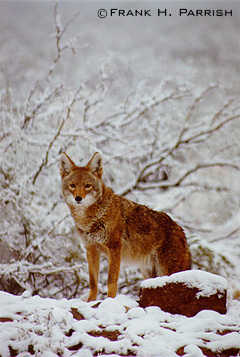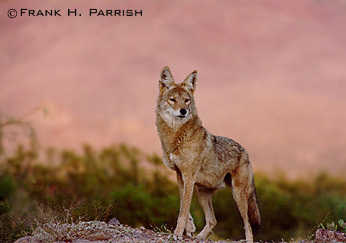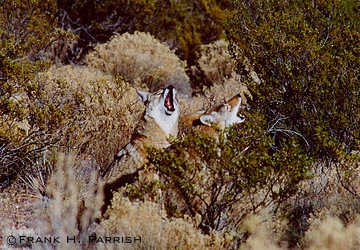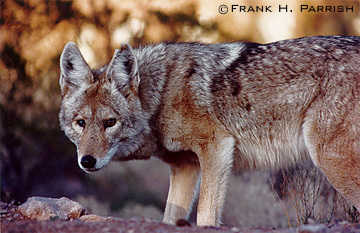[Home Page]
[Gallery, First Floor]
[Gallery, Second Floor]
[Meet the Photographer]
[Order Cards or Prints]
[Contact Frank] |
| |
|
The Prairie Wolf (Coyote)
by Frank H. Parrish
There are many stories replete with the power attributed to
the coyote. One story of the coyote as the purveyor of Good
Medicine took place at Hueco Tanks, east of El Paso, Texas.
A band of Kiowa warriors was overtaken by Mexican soldiers
at Hueco Tanks and a bloody battle took place. One Kiowa was
so badly wounded that he had to be left near a spring. As
the day and night advanced his life seemed to ebb away. In
a semi-comatose state, the Kiowa heard the distant howling
of coyotes. The howling came
|
|
| |
|
|
|
 |
|
|
Coyote
in the snow
|
|
|
|
| |
nearer and the Indian was sure that the coyotes
had smelled his blood and were only waiting for him to die before
feasting. Next he heard soft steps close to his ear. The coyote
came forward and licked his wounds, then laid down quietly by his
side. The Indian was so soothed he fell asleep. When he awoke the
coyote was still lying by his side. The coyote continued licking
his wounds. Soon some strength returned to the Kiowa and he managed
to crawl to the spring to slake his great thirst. The coyote "told"
him that he must endure and that he would get back to his people.
That day six Commanches, friends of the Kiowas, came to the spring,
found him and returned him to a camp of his people. At the next
Sundance he made public his thanksgiving to the coyote. In the calendar
history of the tribe it was the year 1839. (1)
|
|
| |
|
|
The Spanish gave the animal its name
from the Aztec word for the animal: coyotl. Later names were
applied as well in different periods by different peoples.
Such names as "prairie wolf,"
|
|
| |
|
|
|
|
 |
|
|
Gods
Dog
|
|
|
|
| |
"God's Dog," "the trickster,"
and others have been used but he continues to be best known as the
"coyote."
|
|

Howling Coyotes |
| |
|
|
|
The singing of the coyote is the music of the desert
and plains and is much a feel of the West today as it was
in earliest times.
|
|
|
| |
Coyotes appear to be most fond of the duet; two coyotes
singing together. The duet will sound as though there must be six
to ten animals, quite a bluff to any creature unfamiliar with coyote
music. Coyotes are thought to transmit signals to each other through
this coyote lingo; a change in the weather, hunters in the area,
location of kin and most of gloriously, a feeling of gladness and
coyote joy.
|
|
| |
|
|
The resource-
fulness, intelli-
gence and adaptability of the coyote is legendary and is noted
throughout prehistory as well. Its ability to adapt and to
survive is unequaled in North American mammals.
|
|
|

Coyote Portrait
|
| |
|
|
|
The buffalo hunters of the Plains noted that
the coyote very early learned to hang back and wait for the conclusion
to the hunters' work, then proceed to feed on the carcasses left
on the plains.
The coyote has been successful in many instances where less intelligent
and adaptable predators have not. The coyote in Indian lore is credited
with many deeds, which to the skeptical white man, was mythological
nonsense. However this is no longer the case as many deeds of the
trickster are finally being documented through modern man's methods
of photography, video tapes and transmitters. This studying is far
from complete and no doubt will shed more light on the animal for
the sake of science. For the original people of the Southwest however
it is redundant to say the least.
A hundred years from today when the world has changed to whatever
it will be and man's hand is seen in places that even today are
remote, one thing is certain - the singing of the gladness and joy
that we recognize today will be heard in Southern New Mexico and
why not rejoice in song, for the Prairie Wolf's future has
never looked brighter!
1 This account was included in J.Frank Dobie's book
"The Voice of the Coyote."
|
|
|